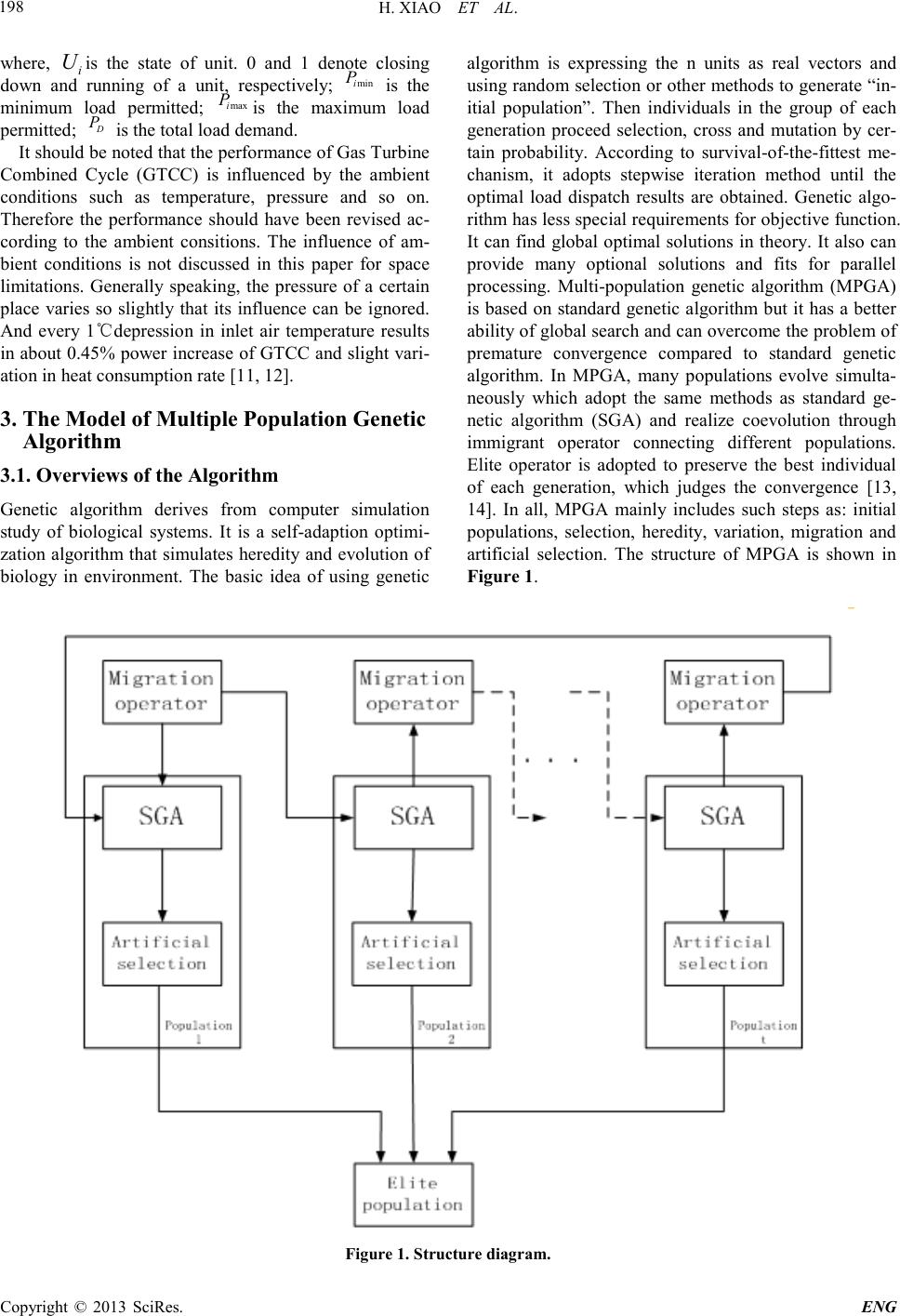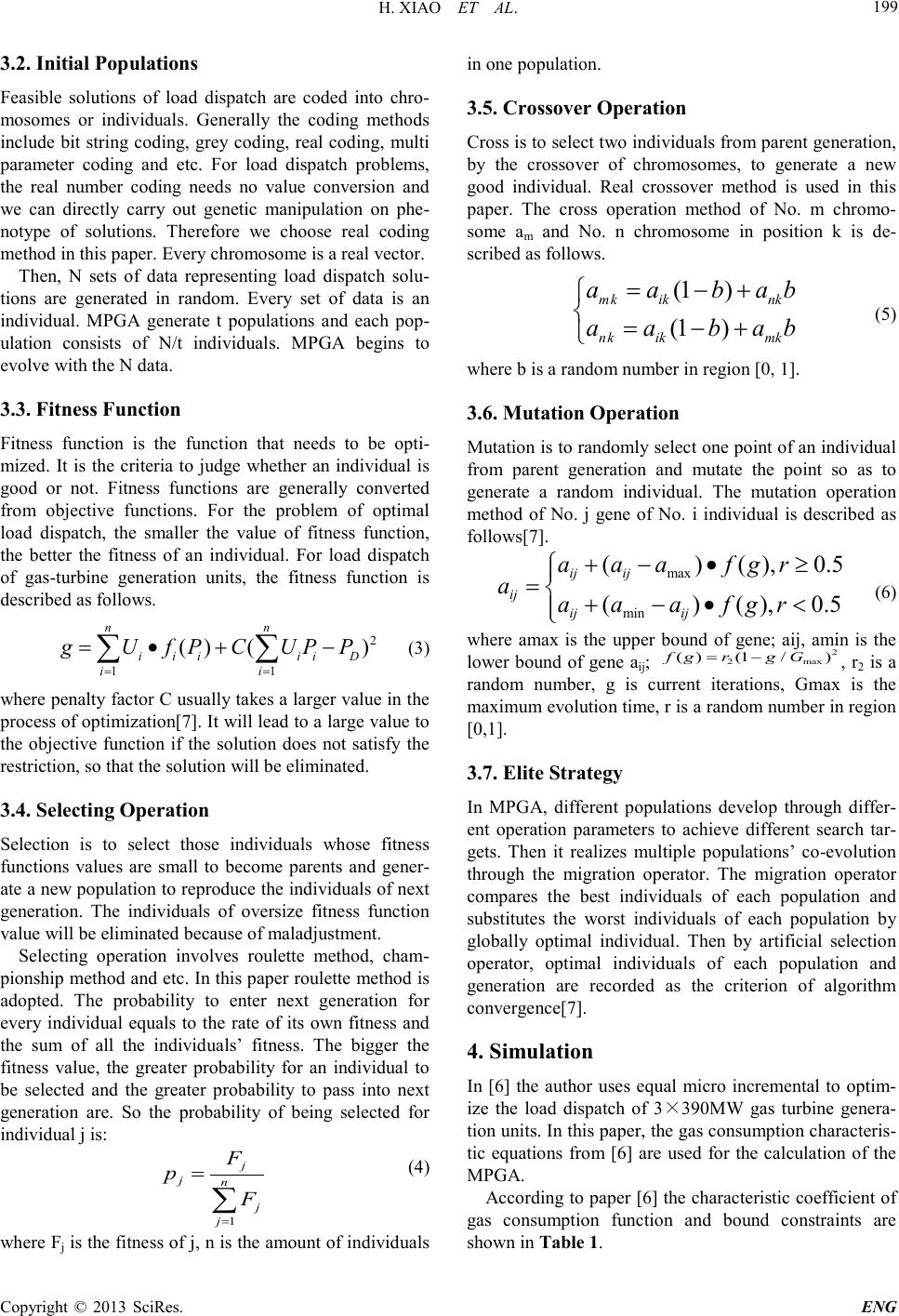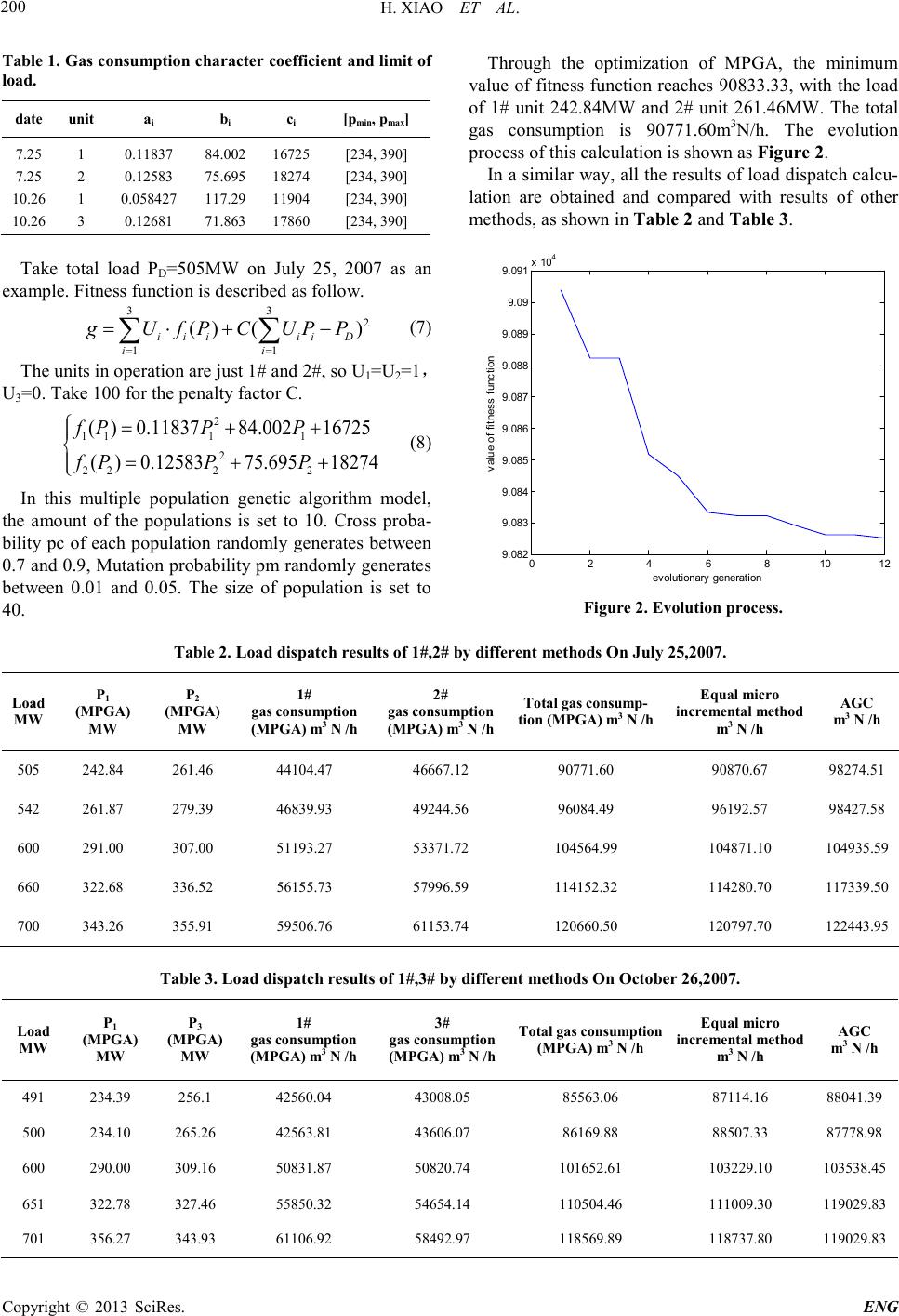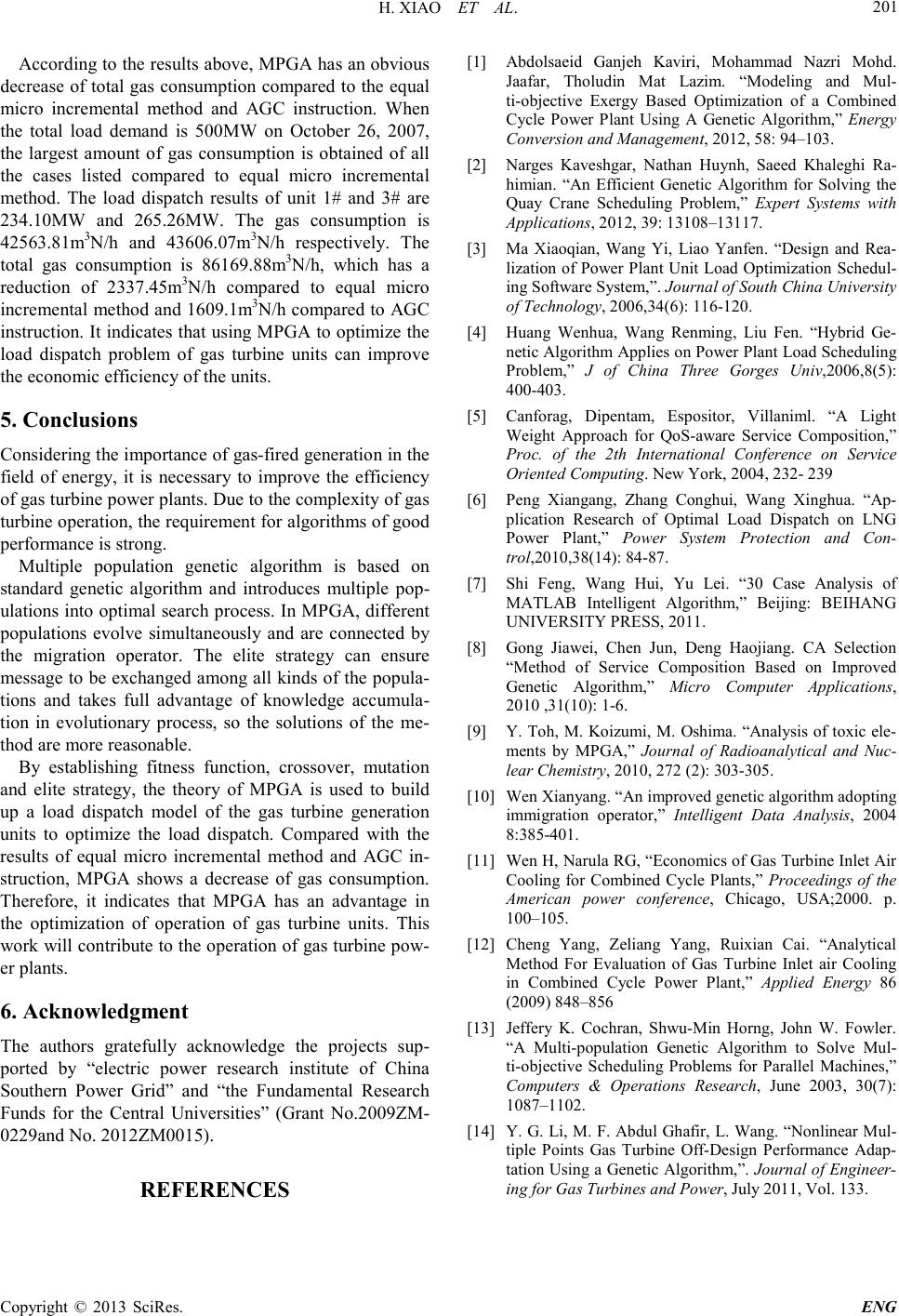Paper Menu >>
Journal Menu >>
 Engineering, 2013, 5, 197-201 doi:10.4236/eng.2013.51b036 Published Online January 2013 (http://www.SciRP.org/journal/eng) Copyright © 2013 SciRes. ENG Optimal Load Dispatch of Gas Turbine Power Generation Units based on Multiple Population Genetic Algorithm Hua Xiao, Cheng Yang, Jie Wu, Xiaoqian Ma College of Electric Power, South China University of Technology, Guangzhou 510640, China Email: xhua2008@163.com, chyang1@scut.edu.cn, jiewu7@163.com, epxq ma@s cut.edu.cn Received 2013 ABSTRACT In this paper, a multiple population genetic algorithm (MPGA) is proposed to solve the problem of optimal load dis- patch of gas turbine generation units. By introducing multiple populations on the basis of Standard Genetic Algorithm (SGA) , con necti ng each po pul ation thr ough i mmigr ant op erato r and pr eservi ng the b est ind ividual s of eve ry gene ratio n through elite strategy, M PGA can enhance the ef ficiency in obtaining the globa l optimal s olution. I n thi s pa per , MPGA is applied to optimize the load dispatch of 3×390MW gas turbine units. The results of MPGA calculation are compared with that of equal micro incremental method a nd AGC instruction. MPGA shows the best performance of optimization under different load conditions. The amount of saved gas consumption in the calculation is up to 2337.45m3N/h, which indicates that the load dispa tc h o ptimization o f gas t urb i ne uni t s via MPGA approach can be effective. Keywords: Gas turbine gener a tion units; Load d ispatch; MPGA; Optimizatio n 1. Introduction The gas turbine centered gas-steam combined cycle with high thermal efficiency, low pollution discharge, short building time and advanced start-stop performances is well-accepted and fast-growing in electricity generation industry. In this situation, it is important to improve the efficiency of gas turbine power plants. Load dispatch is an essential method to improve the economic efficiency which makes the load dispatch optimization a key point. In mathematic s, the problem of optimizing load dispatch is a complex high-dimensional nonlinear problem con- taining i nteger and conti nuous variables [1-4]. With the development of computer technology and ar- tificial intelligence, modern intelligent algorithms show great advantages in solving load dispatch problems, which mainly includes simulated annealing, artificial neural network, ant colony optimization, genetic algo- rithm and chaos optimization [5,6]. Among them, genetic algorithm has a fast develo pme nt d ue to fewer li mits a nd requirements for continuous or differentiable objective function [7]. Moreover, it shows of strong robustness characteristics, global optimization and parallel compu- ting in so lvi ng nonli near pr oble m, whic h ma kes it wid el y applied in optimal operation of power system. Therefore, this paper is to focus on proposing an effi- cient algorithm to solve the the problem of optimal load dispatch of gas turbine generation units. A multiple pop- ulation genetic algorithm is adopted to optimize the cal- culation of load dispatch of a gas-turbine plant in this paper [8-10], which shows a better find-best ability to solve the problem. 2. Optimal Load Dispatch Model of Gas Turbine Generation Units Binomial expression is usually adopted to fit the charac- teristic curve of gas consumption of gas-turbine genera- tion uni ts. The f unction o f gas cons umption ha s the for m as follow. 2 () () i iiiiii f PaPbPc= ++ (1) where ,, iii abc are the gas consumption characteristic coefficients of each unit; i f is the gas consumption of each unit; i P is the load of each unit. Suppose the whole plant has n unit s which c an be p ut into op eratio n and the total load demand is D P . So the goal of the load dispatch is to minimize the total gas consumption by distributing the load to each of the n units reasonably according to their gas consumption characteristics. The load dispatch model can be described as follows. 1 1 min max max 1 min 1 min( ) .. n i ii i n ii D i i ii n ii D i n ii D i FU fP stUP P P PP UP P UP P = = = = = • = ≤≤ ≥ ≤ ∑ ∑ ∑ ∑ (2)  H. XIAO ET AL. Copyright © 2013 SciRes. ENG 198 where, i U is the state of unit. 0 and 1 denote closing down and running of a unit, respectively; mini P is the minimum load permitted; maxi P is the maximum load permitted; D P is the total load demand. It should be noted that the performance of Gas T ur bi ne Combined Cycle (GTCC) is influenced by the ambient conditions such as temperature, pressure and so on. Therefore the performance should have been revised ac- cording to the ambient consitions. The influence of am- bient conditions is not discussed in this paper for space limitations. Generally speaking, the pressure of a certain place varies so slightly that its influence can be ignored. And every 1℃depression in inlet air temperature results in about 0.45% power increase of GTCC and slight vari- ation in heat consumption rate [11, 12]. 3. The Model of Multiple Population Genetic Algorithm 3.1. Overviews of the Algorithm Genetic algorithm derives from computer simulation study of biological systems. It is a self-adaption optimi- zation algorithm that simulates heredity and evolution of biology in environment. The basic idea of using genetic algorithm is expressing the n units as real vectors and usin g rando m selection or other methods to generate “in- itial population”. Then individuals in the group of each generation proceed selection, cross and mutation by cer- tain probability. According to survival-of-the-fittest me- chanism, it adopts stepwise iteration method until the optimal load dispatch results are obtained. Genetic algo- rithm has less special requirements for objective function. It can find global optimal solutions in theory. It also can provide many optional solutions and fits for parallel processing. Multi-population genetic algorithm (MPGA) is based on standard genetic algorithm but it has a better ability of global search and can overcome the problem of premature convergence compared to standard genetic algorithm. In MPGA, many populations evolve simulta- neously which adopt the same methods as standard ge- netic algorithm (SGA) and realize coevolution through immigrant operator connecting different populations. Elite operator is adopted to preserve the best individual of each generation, which judges the convergence [13, 14]. In all, MPGA mainly includes such steps as: initial populations, selec tio n, heredity, variation, migration and artificial selection. The structure of MPGA is shown in Figure 1. Figure 1 . Structure diagra m.  H. XIAO ET AL. Copyright © 2013 SciRes. ENG 199 3.2. Initial Pop ul ati ons Feasible solutions of load dispatch are coded into chro- mosomes or individuals. Generally the coding methods include bit string coding, grey coding, real coding, multi parameter coding and etc. For load dispatch problems, the real number coding needs no value conversion and we can directly carry out genetic manipulation on phe- notype of solutions. Therefore we choose real coding method in this paper. Every chromosome is a real vector. Then, N sets of data representing load dispatch solu- tions are generated in random. Every set of data is an individual. MPGA generate t populations and each pop- ulation consists of N/t individuals. MPGA begins to evolve with the N data. 3.3. Fitness Function Fitness function is the function that needs to be opti- mized. It is the criteria to judge whether an individual is good or not. Fitness functions are generally converted from objective functions. For the problem of optimal load dispatch, the smaller the value of fitness function, the better the fitness of an individual. For load dispatch of gas-turbine generation units, the fitness function is described as follows. 2 11 () () nn ii iiiD ii gUf PCUPP = = =•+ − ∑∑ (3) where penalty factor C usually takes a larger value in the process o f optimizatio n[7]. It will lead to a large value to the objective function if the solution does not satisfy the restriction, so that the solution will be eliminated. 3.4. Selecting Operation Selection is to select those individuals whose fitness functions values are small to become parents and gener- ate a new population to rep roduce the indi vidual s of ne xt generation. The individuals of oversize fitness function value will be eliminated because of maladjustment. Selecting operation involves roulette method, cham- pionship method and etc. In this paper roulette method is adopted. The probability to enter next generation for every individual equals to the rate of its own fitness and the sum of all the individuals’ fitness. The bigger the fitness value, the greater probability for an individual to be selected and the greater probability to pass into next generation are. So the probability of being selected for individual j is: 1 j jn j j F p F = = ∑ (4) where Fj is the fitness of j, n is the amount of individ uals in one population. 3.5. Crossover Operation Cross is to select two individuals from parent generation, by the crossover of chromosomes, to generate a new good individual. Real crossover method is used in this paper. The cross operation method of No. m chromo- some am and No. n chromosome in position k is de- scrib ed as fo l l ows. (1 ) (1 ) mk iknk nk ikmk aab ab aab ab = −+ = −+ (5) where b is a random number in region [0, 1]. 3.6. Mutation Operation Mutation is to r andomly select one po int of an individual from parent generation and mutate the point so as to generate a random individual. The mutation operation method of No. j gene of No. i individual is described as follows[7]. max min ()(),0.5 ()( ),0.5 ij ij ij ij ij aa afgr aa aafgr +− •≥ =+ −•< (6) where amax is the upper bound of gene; aij, amin is the lower bound of gene aij; 2 2 max ( )(1/)fg rgG= − , r2 is a random number, g is current iterations, Gmax is the maximum evolution time, r is a random number in region [0,1]. 3.7. Elite Strategy In MPGA, different populations develop through differ- ent operation parameters to achieve different search tar- gets. Then it realizes multiple populations’ co-evolution through the migration operator. The migration operator compares the best individuals of each population and substitutes the worst individuals of each population by globally optimal individual. Then by artificial selection operator, optimal individuals of each population and generation are recorded as the criterion of algorithm convergence[7]. 4. Simulation In [6] the author uses equal micro incremental to optim- ize the load dispatch of 3×390MW gas turbine genera- tion u nit s. In t hi s pap er , the g as c ons umpt ion c har acteris- tic equations from [6] are used for the calculation of the MPGA. According to paper [6] the characteristic coefficient of gas consumption function and bound constraints are sho wn in Table 1.  H. XIAO ET AL. Copyright © 2013 SciRes. ENG 200 Table 1 . Gas co nsumption cha racter co efficient a nd limit of load. date unit ai bi ci [pmin, pma x] 7.25 7.25 10.26 10.26 1 2 1 3 0.11837 0.12583 0.058427 0.12681 84.002 75.695 117.29 71.863 16725 18274 11904 17860 [234, 390] [234, 390] [234, 390] [234, 390] Take total load PD=505MW on July 25, 2007 as an example. Fitness function is described as follow. 33 2 11 () () ii iiiD ii gUf PCUPP = = =⋅+− ∑∑ (7) The units in operation are just 1# and 2#, so U1=U2=1, U3=0. Take 100 for the penalty factor C. 2 1111 2 222 2 ( )0.1183784.00216725 ( )0.1258375.69518274 fPP P fPPP = ++ = ++ (8) In this multiple population genetic algorithm model, the amount of the populations is set to 10. Cross proba- bility pc of each population randomly generates between 0.7 and 0.9, Mutation p robab ility p m ra ndoml y generat es between 0.01 and 0.05. The size of population is set to 40. Through the optimization of MPGA, the minimum value of fitness function reaches 90833.33, with the load of 1# unit 242.84MW and 2# unit 261.46MW. The total gas consumption is 90771.60m3N/h. The evolution process of this calculation is sho wn as Figure 2. In a similar way, all the results of load dispatch calcu- lation are obtained and compared with results of other methods , as shown in Ta b l e 2 and Table 3. 0 2 46 810 12 9. 082 9. 083 9. 084 9. 085 9. 086 9. 087 9. 088 9. 089 9. 09 9.091 x 10 4 ev ol ut i onary generati on v al ue of fitnes s func t i on Figure 2. Evolution process. Table 2. Load dispatch results of 1#,2# by different methods On July 25,2007. Load MW P1 (MPGA) MW P2 (MPGA) MW 1# gas consumption (MPGA) m3 N /h 2# gas consumption (MPGA) m3 N /h Tot al g as co n sum p- tion (MPG A) m3 N /h Equal micro incremental method m3 N /h AGC m3 N /h 505 242.84 261.46 44104.47 46667.12 90771.60 90870.67 98274.51 542 261.87 279.39 46839.93 49244.56 96084.49 96192.57 98427.58 600 291.00 307.00 51193.27 53371.72 104564.99 104871.10 1 04935.59 660 322.68 336.52 56155.73 57996.59 114152.32 114280.70 117339.50 700 343.26 355.91 59506.76 61153.74 120660.50 120797.70 1 22443.95 Table 3. Lo ad disp a tch r esults of 1#,3# by different methods O n October 26,2 007. Load MW P1 (MPGA) MW P3 (MPGA) MW 1# gas consumption (MPGA) m3 N /h 3# gas consumption (MPGA) m3 N /h Tot al g as co n sum ption (MPGA) m3 N /h Equal micro incremental method m3 N /h AGC m3 N /h 491 234.39 256.1 42560.04 43008.05 85563.06 87114.16 88041.39 500 234.10 265 .26 42563.81 43606.07 86169.88 88507.33 87778.98 600 290.00 309 .16 50831.87 50820.74 101652.61 103229.10 103538.45 651 322.78 327 .46 55850.32 54654.14 110504.46 111009.30 119029.83 701 356.27 343.93 61106.92 58492.97 118569.89 118737.80 119029.83  H. XIAO ET AL. Copyright © 2013 SciRes. ENG 201 According to the results above, MPGA has an obvious decrease of total gas consumption compared to the equal micro incremental method and AGC instruction. When the total load demand is 500MW on October 26, 2007, the largest amount of gas consumption is obtained of all the cases listed compared to equal micro incremental method. The load dispatch results of unit 1# and 3# are 234.10MW and 265.26MW. The gas consumption is 42563.81m3N/h and 43606.07m3N/h respectively. The total gas consumption is 86169.88m3N/h, which has a reduction of 2337.45m3N/h compared to equal micro incremental method and 1609.1m3N/h compared to AGC instruction. It indica tes that using MPGA to optimize the load dispatch problem of gas turbine units can improve the economic effic iency of the units . 5. Conclusions Cons ide ring t he i mport ance of ga s-fired gener ati on i n the field of energy, it is necessary to improve the efficiency of gas t ur b ine powe r p la nt s. Due to the co mplexit y o f gas turbine oper ation, the require ment for algorithms of good performance is strong. Multiple population genetic algorithm is based on standard genetic algorithm and introduces multiple pop- ulations into optimal search process. In MPGA, different populations evolve simultaneously and are connected by the migration operator. The elite strategy can ensure message to be exchange d among a ll kind s of the popula- tions and takes full advantage of knowledge accumula- tion in evolutiona ry process, so the solutions of the me- thod are more reasonable. By establishing fitness function, crossover, mutation and elite strategy, the theory of MPGA is used to build up a load dispatch model of the gas turbine generation units to optimize the load dispatch. Compared with the results of equal micro incremental method and AGC in- struction, MPGA shows a decrease of gas consumption. Therefore, it indicates that MPGA has an advantage in the optimization of operation of gas turbine units. This work will contribute to the operation of gas turbine pow- er plants. 6. Acknowledgment The authors gratefully acknowledge the projects sup- ported by “electric power research institute of China Southern Power Grid” and “the Fundamental Research Funds for the Central Universities” (Grant No.2009ZM- 0229and No. 2012ZM0015). REFERENCES [1] Abdolsaeid Ganjeh Kaviri, Mohammad Nazri Mohd. Jaafar, Tholudin Mat Lazim. “Modeling and Mul- ti-objective Exergy Based Optimization of a Combined Cycle Power Plant Using A Genetic Algorithm,” Energy Conve r si on an d Managem e nt , 20 12, 58: 94–103. [2] Narges Kaveshgar, Nathan Huynh, Saeed Khaleghi Ra- himian. “An Efficient Genetic Algorithm for Solving the Quay Crane Scheduling Problem,” Expert Systems with Applications, 2012, 39: 13108–13117. [3] Ma Xiaoqian, Wang Yi, Liao Yanfen. “Design and Rea- lization of Power Plant Unit Load Optimization Sch edul- ing Software Syst em,”. Journal of South China University of Technology, 2006,34(6): 116-120. [4] Huang Wenhua, Wang Renming, Liu Fen. “Hybrid Ge- netic Algorithm Applies on Power Plant Load Scheduling Problem,” J of China Three Gorges Univ,2006,8(5): 400-403. [5] Canforag, Dipentam, Espositor, Villaniml. “A Light Weight Approach for QoS-aware Service Composition,” Proc. of the 2th International Conference on Service Oriented Computing. New York, 2004, 232- 239 [6] Peng Xiangang, Zhang Conghui, Wang Xinghua. “Ap- plication Research of Optimal Load Dispatch on LNG Power Plant,” Power System Protection and Con- trol,2010,38(14): 84-87. [7] Shi Feng, Wang Hui, Yu Lei. “30 Case Analysis of MATLAB Intelligent Algorithm,” Beijing: BEIHANG UNIVERSITY PRESS, 2011. [8] Gong Jiawei, Chen Jun, Deng Haojiang. CA Selection “Method of Service Composition Based on Improved Genetic Algorithm,” Micro Computer Applications, 2010 ,31(10): 1-6. [9] Y. Toh, M. Koizumi, M. Oshima. “Analysis of toxic ele- ments by MPGA,” Journal of Radioanalytical and Nuc- lear Chemist ry, 2010, 272 (2): 303-305. [10] Wen Xianyang. “An improved genetic algorithm adopting immigration operator,” Intelligent Data Analysis, 2004 8:385-401. [11] Wen H, Naru la RG, “Econ omics o f Gas Turbine Inlet Air Cooling for Combined Cycle Plants,” Proceedings of the American power conference, Chicago, USA;2000. p. 100–105. [12] Cheng Yang, Zeliang Yang, Ruixian Cai. “Analytical Method For Evaluation of Gas Turbine Inlet air Cooling in Combined Cycle Power Plant,” Applied Energy 86 (2009) 84 8–856 [13] Jeffery K. Cochran, Shwu-Min Horng, John W. Fowler. “A Multi-population Genetic Algorithm to Solve Mul- ti-objective Scheduling Problems for Parallel Machines,” Computers & Operations Research, June 2003, 30(7): 1087–1102. [14] Y. G. Li, M. F. Abdul Ghafir, L. Wang. “Nonlinear Mul- tiple Points Gas Turbine Off-Design Performance Adap- tation Using a Genetic Algorithm,”. Journal of Engineer- ing for Gas Turbines and Power, J ul y 2011, Vol. 133. |

